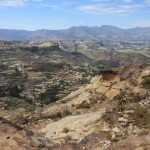- Stay Connected
Ethiopia’s drought overlooked as aid funneled to more desperate crises

Addis Ababa’s efforts have managed the country’s worst drought in decades – but stymied needed international help.
DAGA HAMUS, Ethiopia — Inside a health clinic in northern Ethiopia a nurse wraps a special tape measure around the upper arm of 9-month-old Aixiet, cradled in her mother’s arms.
It reads red — “severely” malnourished, according to Elsa Aduma, a nurse at the center run by the Catholic Daughters of Saint Anne.
“I can’t produce enough milk as there’s not enough food for me to eat at home,” says Aixiet’s mother, 32-year-old Amete Kahsay, gesturing to her breasts. “Can I get something here for my baby?”
“We can’t do anything,” Aduma says, adding the mother might be able to find Ready-to-Use Therapeutic Food (RUTF), a fortified peanut butter-like nutritional supplement with a high vitamin and mineral content, at a nearby government-run clinic — though she can’t be sure.
By some estimates, Ethiopia’s current drought may be the worst the country has seen in 50 years. But, so far, there are no scenes reminiscent of 1984, when Ethiopia’s most infamous drought contributed to more than one million Ethiopians dying.
This is due to a partially successful response from the Ethiopian government, which has thus far managed to prevent a famine. Still, there are many going hungry, and a crisis could be imminent. And the government’s mixed success on the issue means that international efforts are lacking.
Read more
